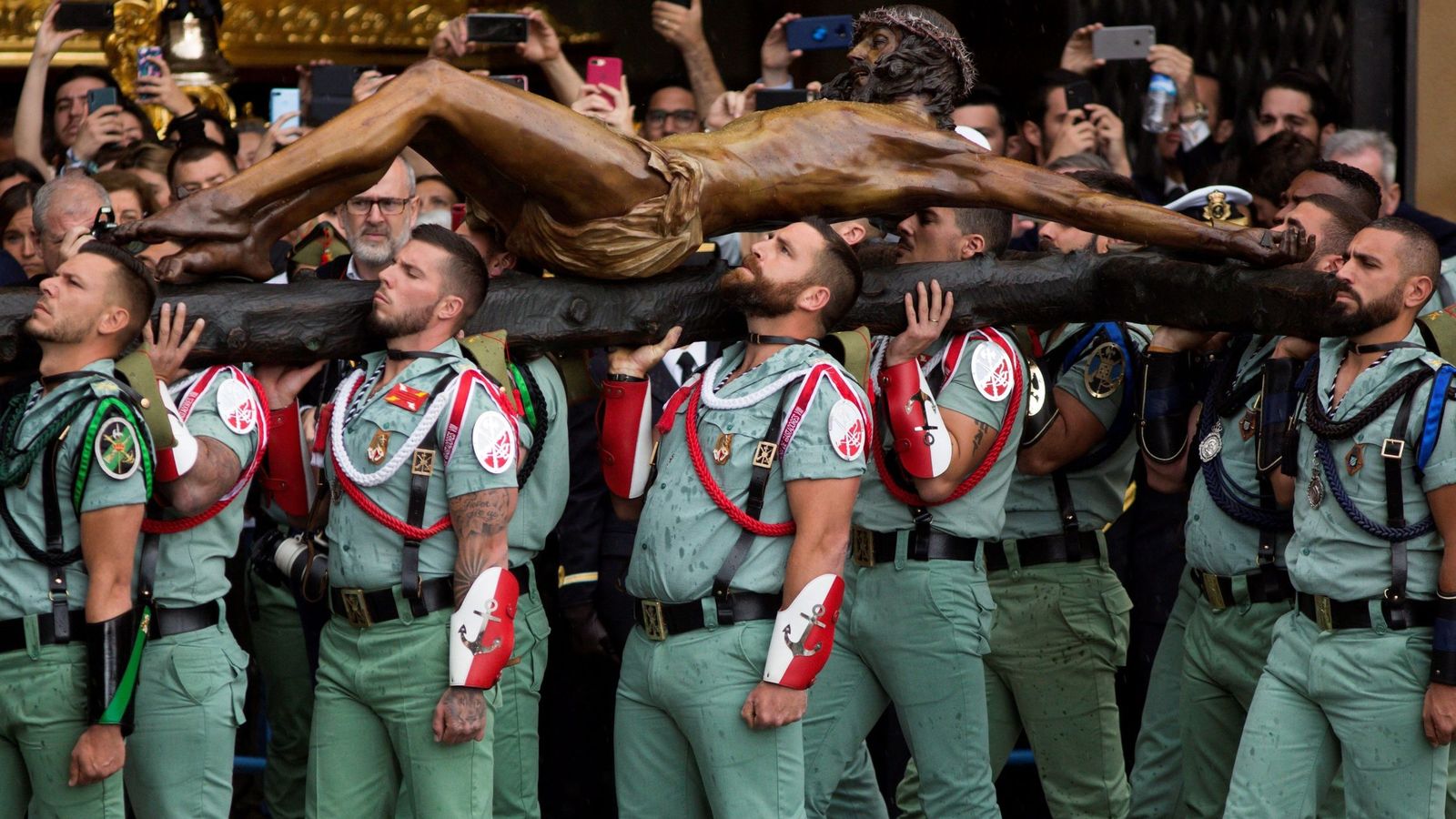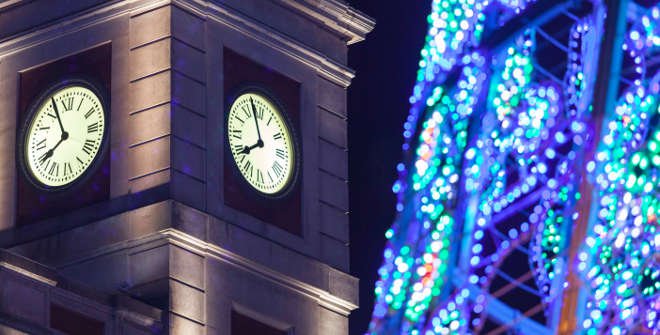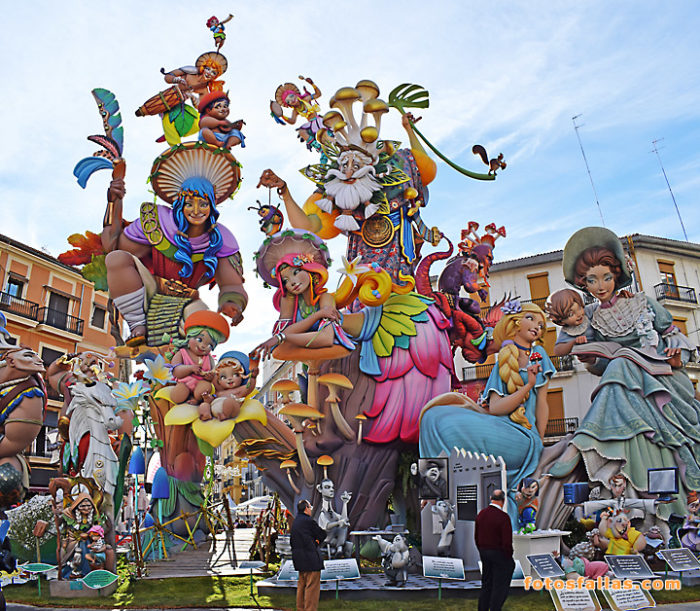Spain - Culture And Traditions
-

La Legión has participated today in one of the most beautiful events in the entire Spanish Holy Week, "El Traslado Del Cristo De Mena" in Málaga, Andalucía. The rain didn't allow La Legión to make the event as other years, but still, it's a beautiful event you can't miss if you come to our country in Holy Week.
The "Cristo De Mena" is asculpture from the XVII century, that was destroyed in 1937. It was re-builded, and this is only the replica of the destroyed Christ.
-
A beautiful tradition.
-

El Sorteo de Navidad, when you can become a millionaire and share the happiness with everyone
It's most possible to fall down walking down the street than be awarded with El Gordo de la Lotería de Navidad. The raffle was celebrated the 22nd of December, day when this picture was taken, and the number that was awarded with the 1st Prize (El Gordo) was 26590. So, if you've visited us and you've bought a tenth-share in a lottery ticket, then, check it in this webpage. Maybe you've been awarded, who knows... Good luck!
If you're awarded with something, then you might want to come to Spain before the 22nd of March; that is the last day to collect the prize
-
HAPPY NEW YEAR!!!

In Spain, we've a lot of diversity among how do we celebrate Nochevieja (New Year's Eve). So, why not to have a guided tour along all Spain to discover what do we do on Nochevieja? If you want to discover our traditions, then all aboard to this train along all the Spanish regions!

Option 1: Eating the 12 Lucky GrapesIf you want to be lucky and recive the new year eating our delicious grapes, then, you need to come to Spain. This tradition started between 1903 (in the Canary Islands) and 3 years later, in the rest of Spain. It's believed that a surplus on a harvest of grapes made some farmers from Alicante (Comunitat Valenciana or Valencia) create a new legend about the grapes. Since then, we eat grapes in most of the regions. In Grequia, they eat lentils.

The Countdown And Fireworks
In the rest of the regions, we just make a countdown and then, boom! Fireworks show all along the country starts. We also have fireworks after eating our 12 lucky grapes. So don't worry, we do have fireworks everywhere, and even people buy their own fireworks, they set fire to the fireworks and then, let the show start.
-
THIS WEEK IN VALENCIA - LAS FALLAS

Fireworks, noise, rare and funny sculptures, fire... Welcome to Valencia and to its Fallas! The Fallas are a very famous touristical attraction in Spain. Every year, they attract millions of people. But, where does it comes from?
There are different conjectures regarding the origin of the Fallas. One suggests that the Fallas started in the Middle Ages, when artisans disposed of the broken things and pieces of wood they saved during the winter by burning them to celebrate the spring equinox. Valencian carpenters used planks of wood called parots to hang their candles on during the winter, as these were needed to provide light to work by. With the coming of the spring, they were no longer necessary, so they were burned. Over time, and with the intervention of the Church, the date of the burning of these parots was made to coincide with the celebration of the festival of San José, the patron saint of carpenters. On March 19th, S. José day, Spain also celebrates father's day. The Fallas end with La Nit De La Cremà, when all the statues (except the one that won the contest) are burned down.

-
PRIDE WEEKEND

Citizens have taken the streets during all the weekend to demonstrate in order to celebrate the Pride Weekend. Madrid, Antequera, Paris and Londres have been the main epicentres of this demonstrations. The Government has said that around 6 million people, from Spain and other places of the European Union, have took part on these demonstrations. After that, a letter was red by Carlos Sobera.
Incidents have been reported with the far-right party VOX, who was asked to leave. "YOU DON'T FIGHT FOR US, YOU OPRESS US", someone said. The police had to scourt them as many people were shouting and, according to the party Leader, Santiago Abascal, "putting in risk their security and integrity."
-
SAN FERMÍN, THE MOST INTERNATIONAL PARTY OF SPAIN

It's 6th July, which means that when the clock says it's 12 o'clock, the party will start. 204 continued hours of parties, fun and lots of bull races will take Pamplona's streets. Every year, lots of people from all around the European Union come to Pamplona just to run in front of the bulls. This year, the hotels have reached a 95% of capacity, which means that lots of persons will be attending to the most-known Navarra's celebration. The Pamplona's mayor, Enrique Maya, has said: "I'm very excited about lots of people coming into Pamplona this year to enjoy our beautiful tradition. Inquistans, Gaullois, Fremetian, Nicoleizians, Vayinaodics, Duxburbians... Everyone is coming to our city, and that's something fantastic."
The San Fermín's calendar seems like this:
- 7th July - Fuente Ymbro
- 8th July - Victoriano del Río
- 9th July - José Escolar
- 10th July - Cebada Gago
- 11th July - Jandilla
- 12th July - La Palmosilla
- 13th July - Núñez del Cuvillo
- 14th July - Miura
The Spanish Public Radio and Television Service (RTVE) and the Autonomic Newspaper, Diario de Navarra, will be offering a special coverage during the Sanfermines. We hope you enjoy your stay in Pamplona!
-
La Tomatina de Buñol

The last Wednesday of August, la Tomatina de Buñol takes place. The tomatina's participants throw tomatoes and get involved in a tomato fight purely for entertainment purposes and it takes place in Buñol's streets, which is a town of Alicante, Comunitat Valenciana. La Tomatina Festival started the last Wednesday of August in 1945 when some young people spent the time in the town square to attend the Giants and Big-Heads figures parade. The young boys decided to take part in a parade with musicians, Giants and Big-Heads figures. The energy of jovialities caused one participant's Big-head to fall off. The participant flew into a fit of rage, began hitting everything in his path. There was a market stall of vegetable that fell victim to the fury of the crowd. People started to pelt each other with tomatoes until the local forces ended the fruit battle.
The Tomatina was banned in the 50s, with the Francisco Franco's dictatorship. In 1957, there was a demonstration in which the residents carried a coffin with a huge tomato inside. The parade was accompanied by a music band which played funeral marches. The protest was successful. La Tomatina Festival was finally permitted and became an official festival. In 2002, La Tomatina of Buñol was declared Festivity of International Tourist Interest by the Secretary Department of Tourism due to its success.
 The Kingdom of Spain
The Kingdom of Spain